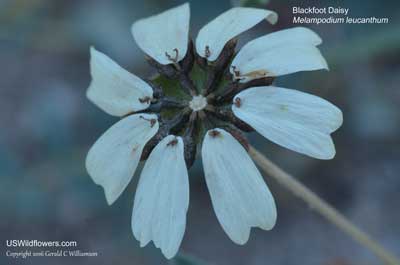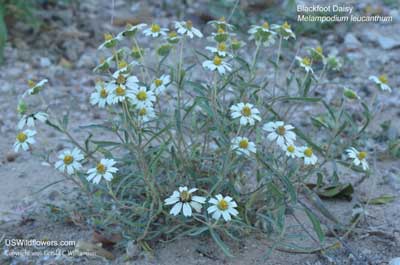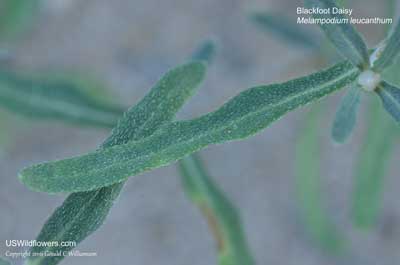Blackfoot Daisy, Rock Daisy, Plains Blackfoot, Arnica - Melampodium leucanthum
| Family: Asteraceae - Aster family | Genus Common Name: Blackfoot | Native Status: Native | Dicot Perennial Herb Subshrub Leaves:Compound Leaf-margin:Entire Inflorescence:Solitary Inflorescence:Terminal |
|
Melampodium leucanthum - Blackfoot Daisy, Rock Daisy, Plains Blackfoot, Arnica. Melampodium is a fairly small genus, with about 36 species native to North and South America (some introduced in Europe), and 7 species found in North America. 5 of those 7 have yellow ray flowers; only Melampodium cinereum (Hoary Blackfoot), found in the United States only in south Texas, and the species shown here, M. leucanthum (Blackfoot Daisy), have white ray flowers. Blackfoot Daisy has a wider distribution (the widest distribution of any Melapodium in the United States), being found in Texas and 5 other states north and westward. Its range overlaps with M. cinereum in a few Texas counties, and there some plants have intermediate traits, leading some authorities to think they should be classified as a single species. Melampodium leucanthum grows in open grasslands and desert scrublands, blooming as early as March and as late as November at altitudes up to about 8,000 feet.
Found in:
AZ, CO, KS, NM, OK, TX
Leave comments on Melampodium leucanthum at this link. | 
Distribution of Melampodium leucanthum in the United States and Canada:

Blue=Native; Grey=Introduced
Map from USDA Plants Database:
USDA, NRCS. 2017. The PLANTS Database (http://plants.usda.gov, 08 May 2025). National Plant Data Team, Greensboro, NC 27401-4901 USA.
Search Our Database: Enter any portion of the Scientific, Common Name, or both.
Do a general Google search of the entire site:
#ad
 Follow USWildflowers on Twitter
| | Site: Brantley Lake State Park, Eddy County, NM Date: 2016-October-19 | Photographer: Gerald C. Williamson
Nikon D7000
Tamron SP 90MM f/2.8 AF Macro | | The composite flower of Blackfoot Daisy has 7 to 13 creamy white, fertile ray florets (sometimes with purplish tinting on the underside.) It has 25 to 60 yellow, 5-lobed, staminate disc florets. | | 
| | Site: Brantley Lake State Park, Eddy County, NM Date: 2016-October-19 | Photographer: Gerald C Williamson
Nikon D7000 | | This is the flower after the disc florets have dropped and the seeds are beginning to form from the ovaries of the ray florets. There is some speculation as to the naming of this genus, with one account saying that it isn't from the Greek word "melampodion" - being literally translated to "black foot," but is instead traced to the Greek mythological figure Melampus. I've also read one account that said it was from the coloration of the stem base and root. However, looking at this photo, I'm inclined to subscribe to the Greek black foot origin, as this looks like the ray florets have "melampodion." | | Click on the photo for a larger image

| | Site: Brantley Lake State Park, Eddy County, NM Date: 2016-October-19 | Photographer: Gerald C Williamson
Nikon D7000 | | Blackfoot Daisy is a short plant, usually 5 or 6 inches high, rarely growing as tall as 15 to 18 inches tall. They grow in clumps up to two feet across. The leaves are opposing on the stems and are pinnately lobed with 1 to 6 lobes (Melampodium cinereum may have as many as 10 lobes.) In this photo, most leaves have a single lobe (I'd call that unlobed), but many have 3 lobes, with most of the lateral lobes much shorter than the terminal lobe, so the pinnate lobing is not obvious. | | Click on the photo for a larger image

| | Site: Brantley Lake State Park, Eddy County, NM Date: 2016-October-19 | Photographer: Gerald C Williamson
Nikon D7000 | | The face leaf face is moderately hairy. The leaflet blades are linear, perhaps with a bit of oblong or lanceolate shape to them. | | Click on the photo for a larger image

|
References used for identification and information:
|
|
| |
| #ad
|
|






